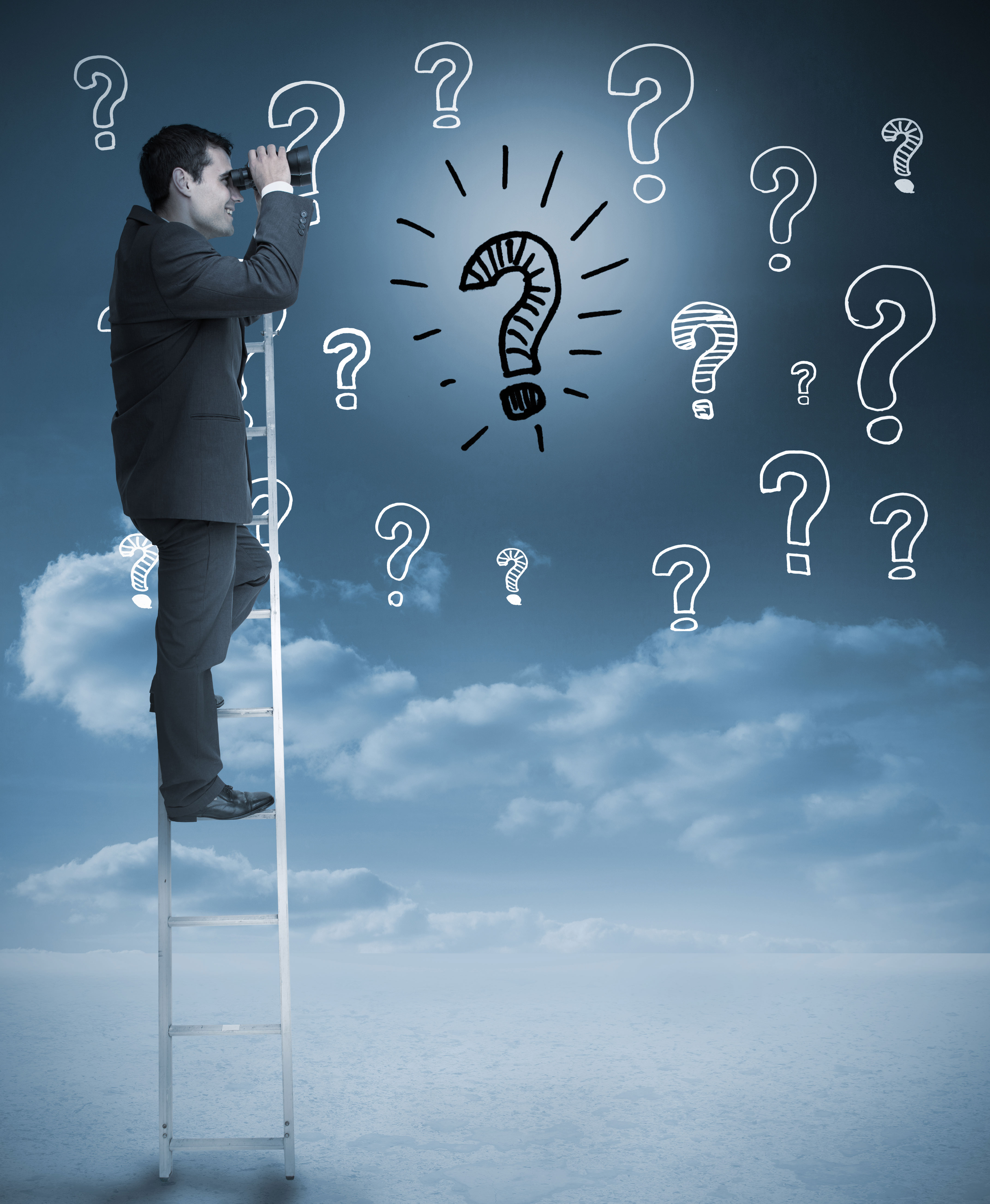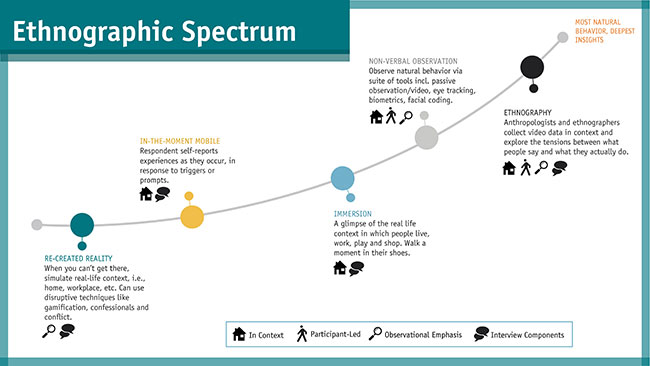Learning as they go
Editor's note: Based in Cincinnati, Karin O’Neill is vice president of innovation at Ipsos UU. Based in Portland, Maine, Liza Walworth is vice president, U.S. ethnography center of excellence at Ipsos UU.
 Today, the term “ethnography” gets applied to a range of consumer research techniques involving far more than just sending researchers into people’s homes. New methods that fall broadly under the ethnographic umbrella are helping marketers uncover and understand the complexities and tensions that live within what people say and do – especially when words and deeds seem to conflict. As researchers become inundated with more and more big data, they need human stories and human truths to illustrate and explain the insights behind that data. But which technique – self-reported mobile, directed immersions, re-created reality or full ethnography – is right for your project?
Today, the term “ethnography” gets applied to a range of consumer research techniques involving far more than just sending researchers into people’s homes. New methods that fall broadly under the ethnographic umbrella are helping marketers uncover and understand the complexities and tensions that live within what people say and do – especially when words and deeds seem to conflict. As researchers become inundated with more and more big data, they need human stories and human truths to illustrate and explain the insights behind that data. But which technique – self-reported mobile, directed immersions, re-created reality or full ethnography – is right for your project?
While the term ethnography is used broadly and loosely in our industry, there is a distinction between actual ethnography and those methods that merely leverage its principles. Anthropologically-based ethnography is participant-led, observationally-driven, in situ and takes place over an extended period. Several other methodologies borrow certain principles from ethnography to enrich qualitative learning across a spectrum of techniques (Figure 1). Each methodology addresses specific learning objectives. Let’s go through each one and discuss the features and benefits of incorporating different forms of ethnographic research into your learning plans.

Ethnography
Ethnography delivers some of the deepest insights about consumers because it’s a means of seeing consumers’ real lives in a very natural, uninterrupted way over a day’s time or more – on their terms, not yours. Ethnographers draw upon the model of participant-observation fieldwork utilized within anthropology. Typically, an expert ethnographer conducts the fieldwork alone, to minimize disruption to the respondents. The ethnographer follows them through their normal activities, potentially recording footage that can be analyzed with the client afterward (sometimes referred to as video ethnography). Ethnographers are trained to observe and query cultural and environmental contexts, personal relationships and emotions that influence the beliefs and behaviors observed. And while the ethnographers start with observation, they do ask questions to better understand what they observe, which offers a unique opportunity to explore the tensions between what people say they do and what they actually do.
Ethnography is thus best suited for early, foundational studies, when the “why” behind the “what” is unknown and hypotheses are few. Ethnographers start with consumers and work to understand how a product, service, category or need fits into their lives. As such, ethnography tends to be a broad exploration. While it might produce as many questions as it does answers, those questions will be sharper and smarter than those generated via guesswork or claimed behavior alone.
One common application is developing an understanding of unarticulated needs at the beginning of a product or service innovation project. For example, in one case, our ethnographers worked with a CPG manufacturer and discovered that while consumers rated the current product well they had incorporated a variety of different compensating behaviors into their routines. These behaviors showed dissatisfaction with the current product and highlighted potential areas for improvement and innovation.
Another application for ethnography is communication development. A common complaint we hear from marketers is that creative is falling flat and not connecting emotionally with consumers. Ethnography can help marketers identify the emotional context(s) of the category and how it fits into consumers’ daily lives. The human stories observed and unearthed can inspire creative teams and, in some cases, be referenced in copy. For example, one of our clients leveraged Ipsos’ syndicated work on psoriasis to better understand the quality of life and struggles of psoriasis patients. The client’s brand subsequently adjusted its positioning and changed the tone of its communication to better relate to patients.
Ethnography is also a great way to understand actual consumer behavior before designing a quantitative segmentation or habits and practices study. In one project, a client’s standard category questions contained several assumptions about product storage and usage, including the notion that people used products in a certain order. When we spent time with consumers, we uncovered insights about actual behavior, which included mixing products together. We also observed how storage fit into their daily routine and environment. This led to a redesign of quantitative questionnaires for more accurate results.
While ethnography can deliver deep insights, it’s not right for every scenario, especially when time or budget are limited or when the project is farther along and has fewer unknowns. Also, as mentioned, ethnography is best conducted by a solo expert researcher to avoid disrupting or impacting the consumer experience. If your project team needs to meet the consumer firsthand and not via video, you may want to consider incorporating immersions into your learning plan.
Immersions
Immersions typically take place over a shorter period of time (hours, not days) and can include prompts for the subject, which would be frowned upon in an ethnography. The task- and/or product-centric focus of immersions make this methodology a powerful tool. Immersions tend to quickly zero in on the category or need being studied. Imagine a researcher asking a respondent, “Do you mind showing me how you prep and wash your delicates?” Immersions are therefore appropriate for more directed lines of questioning and the testing of hypotheses that often occur a bit farther into a research process – perhaps on the heels of prior ethnographies, for example, such as when a detailed patient journey is needed to complement the broader, contextual understanding of how a patient and his/her caregiver live day-to-day with a specific health condition.
One common objective for immersions is when you want to ensure a project is on the right path. Periodic immersions with your design target – the consumers who inspire your project – can provide the insights to move your team forward to the next phase of design, while offering a chance to get gut reactions to some stimulus and course correct as needed.
Another objective for immersions is when a team needs to become closer to the consumer. Maybe you just finished a big segmentation study and need some deeper insights or to immerse the team with the new segments. Or perhaps you have a leadership team or agency who doesn’t seem to relate to the consumers; getting them to spend time with them face-to-face is often the breakthrough needed to change that dynamic. After the teams go through part of a day with consumers and see their challenges firsthand, team members are likely to have the empathy and understanding needed to positively impact their everyday decision-making.
Non-verbal observation
Passive or non-verbal observation exposes natural, uninterrupted behavior. However, its strength can also be a limitation – because you can’t ask questions, you must make some assumptions as to what is happening and why. In many cases, a learning plan will pair passive observation with other methodologies, such as an interview, to address this shortcoming and deliver holistic insights. A good application of non-verbal observation is to understand a consumer experience, such as product usage or taking medication, in a very thorough way. Non-verbal observation captures what truly happens as opposed to what someone might think typically happens – for example, how often does a family really open their fridge within a 24-hour period? In this scenario, fixed cameras could be installed and footage analyzed to identify unconscious behaviors or the patterns of some family members that go unnoticed by others. If you observe pain points in the usage experience, these can be product innovation or upgrade opportunities. Conversely, if you uncover moments of delight, like when a product experience causes a sensation that people pause to enjoy, you can show this in your advertising or shelf materials. This is a great way to turn in-use product delighters into trial-drivers!
In-the-moment mobile
Mobile is a powerful tool, because it’s the rare consumer, customer or patient who leaves home without their devices. Because mobile is always with us, it can help us understand how consumers view their experiences as they happen, wherever they happen. That includes places and times that are difficult for us to access as researchers. We often use mobile to understand how a consumer experience varies throughout the day or week, during different kinds of weather, at home or at school or while shopping or at the doctor’s office. Rich input including video, images and text is easy to collect. One key limitation of mobile that is important to note, however, is that it provides the consumer’s crafted and edited view of an experience – you are seeing what they want you to see, versus being there to observe everything firsthand. In categories or situations where social pressure plays a greater role in how people respond, you may want to incorporate an observational methodology into your learning plan to complement the mobile component.
Re-created reality
We realize it’s not always possible to observe the consumer, customer or patient situation in real life. Alternatively, maybe you need to create a situation or use a prototype that doesn’t yet exist in real life. You might have a looming deadline and need to learn quickly on several objectives, some of which are observational in nature, at the same time. Simulating a real-life environment like a home, store or doctor’s office can help you gain some observational insights while addressing these other needs. With many of our clients, we wire a full house with cameras and have different consumer activities in different rooms, e.g., observation in one, a “confessional” in another, a gamified exercise in a third. Clients can participate or observe in a designated “back room.” This kind of approach can be a great way to accelerate learning, hitting upon multiple objectives at once or bringing fresh insight when it seems like you’ve asked all the questions in a category.
Drive action
No matter which method you choose, research is only as good as the action it inspires. Don’t debrief and dash. Instead, plan for activation exercises or workshops that bring the insights to life and drive action. Whether it’s a 360-degree video deliverable that brings the immersive experience to decision makers or a workshop with specially-designed exercises to make the full team feel as the consumer does, plan for experiences that drive action.
